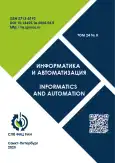Informatics and Automation
ISSN (print): 2713-3192, ISSN (online): 2713-3206
Media registration certificate: ПИ № ФС 77 - 79228 from 25.09.2020
Founder: St. Petersburg Federal Research Center of the Russian Academy of Sciences
Editor-in-Chief: Ronzhin Andrey Leonidovich, Dr. Sci., Professor of RAS
Frequency / Assess: 6 issues per year / Open
Included in: White List (2nd level), Higher Attestation Commission List, RISC, Scopus
"Informatics and Automation" is a scientific, educational, and interdisciplinary journal primarily intended for papers from the fields of computer science, automation, and applied mathematics. The journal is published in both printed and online versions. The printed version has been published since 2002, the online one since 2010. Frequency: 6 times in year. Fee for the processing and publication of an article is not charged. The maximum term of the paper’s reviewing comprises 3 months.
Ағымдағы шығарылым
Том 24, № 5 (2025)
Robotics, automation and control systems
The Method of Intelligent Mission Planning for Autonomous Underwater Vehicles
Аннотация
 1257-1283
1257-1283


Integrated Algorithm for Multi-Criteria Group Decision-Making in Evacuation Tasks
Аннотация
 1284-1332
1284-1332


Neural Network Tuning of the Genetic Algorithm for Controlling a Vector Hierarchical System
Аннотация
 1333-1354
1333-1354


State Estimation of an Agent with Stochastic Dynamics Using Recurrent Filters
Аннотация
 1355-1378
1355-1378


Machine Learning Applications for Delivery Time Prediction and Freight Planning
Аннотация
 1379-1407
1379-1407


Artificial intelligence, knowledge and data engineering
A Novel Approach to EEG Artifact Removal Using ADASYN and Optimized Hierarchical 1D CNN
Аннотация
 1408-1443
1408-1443


Technique for Identifying Texts Generated by Large Language Models
Аннотация
 1444-1470
1444-1470


Information security
Model of a Critical Information Infrastructure Cloud Platform with Cyber Immunity
Аннотация
 1471-1505
1471-1505


A Graph Similarity Calculation Algorithm and Its Application for Comparing Binary Executable Files
Аннотация
 1506-1531
1506-1531












